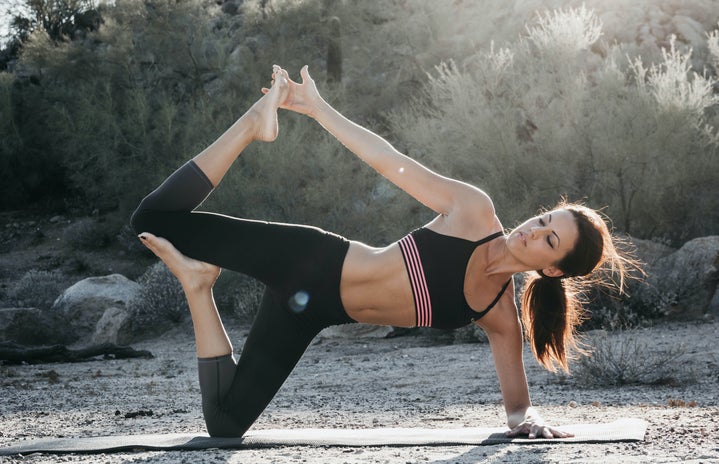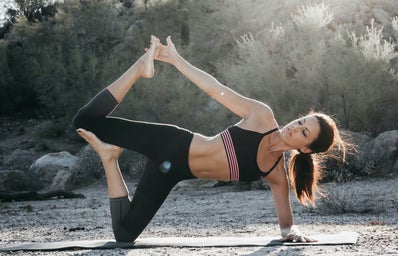‘Wellness’, as defined by the World Health Organisation, is “a state of complete physical, mental and social well-being”. The definition does not tell me who can seek ‘wellness’, or by what means. So why is it that when I type ‘#wellness’ into Instagram, I am besieged by images of young, taut white women performing yoga on a beach, or holding a green juice? Plus, you can bet that there isn’t a carb in sight (although there are plenty of avocados!). Does the ‘#’ narrow the definition of wellness to only include those who fit into one Instagrammable archetype? Of course not, though there’s no disputing that how wellness is represented online has some darker repercussions on the lives of normal women.
An influencer or a blogger is free to follow: we all know this. What’s not as obvious is that her accessibility compared to a qualified professional, married with her personability and the exhibition of her unblemished life, means that the advice she gives to her followers is often trusted more than scientifically-proven information. In fact, 42% of people on social media use it to seek advice about food, with this proportion being higher among young women. Don’t think you’re immune either. Even the most clued-up women can subconsciously internalise the norms presented by wellness influencers surrounding what we should consume or do in order to be healthy. This affects all of us.
Clean eating is dead *sips celery juice* isn’t it?
The recent celery juice trend originates from the ‘Medical Medium’ who, despite his title, draws his knowledge from spirits that tell him how to ‘heal’. So just to reiterate: he has absolutely zero medical or nutritional qualifications (nor do his spirits). His rationale resembles that of Robert Young, whose alkaline ‘Miracle’treatment landed him jail time for defrauding terminally ill cancer patients. In spite of this, the celery juice movement is endorsed by many high-profile women in wellness. Jordan Younger (@thebalancedblonde), a salt, oil and sugar-free plant-based wellness blogger with 200,000 followers on Instagram, insists that celery juice is key to fighting off her Lyme disease. She writes:“Once we strengthen and regenerate our cells, inflammation goes down and disease dies off”.
Judging from this, it seems that in our endless pursuit of wellness, we have not learnt from past mistakes. From the second we log into our social media, women are exposed to an echo-chamber of pseudoscience-informed beliefs rooting from an attachment to clean eating.
Within the space of a year, 57% of women in the United Kingdom will be on a diet (though the pursuit of wellness may be viewed as a ‘lifestyle’). More extreme than this, women account for two thirds of people at risk of orthorexia nervosa: an eating disorder characterised by various food rules such as an obsession with only consuming ‘pure’ foods. Orthorexia is not recognised as an official diagnosis because it manifests itself in a range of ways. But having said that, the vastly different manifestations of orthorexia reflect the plurality of contradicting beliefs promoted by the wellness community. One study of ex-students of Ashtanga yoga found 86% prevalence of orthorexia risk, illustrating that while healthy eating is a natural component of yoga, it’s easy to fall down the rabbit hole of excessively rigid food rules.
Overarching the food rules though, is clean eating. Far more than a diet, It is a belief system which seems to be at the core of wellness culture in the media. It entrenches a hierarchy – whereby foods are considered either ‘pure’ or ‘impure’ – that cannot be voided from somebody’s mind just because the explicit concept of clean eating was denounced back in 2017. Instead, clean eating has been given a friendly new face. The buzzwords ‘detox’ and ‘purify’ are thrown around liberally. A crash diet is a ‘cleanse’. And above all, the thought of using white sugar over agave nectar or maple syrup (despite it being five times cheaper yet no less healthy) makes our skin crawl.
Clearly, wellness has been expropriated in the age of the influencer. With the constant exhibition of peoples’ lives on social media, we now measure how ‘healthy’ someone is by judging the presentation of their lifestyle and appearance. The popularity of influencers is largely based on their appearance – and we faithfully follow the advice that these ‘goddesses’ of wellness give to the masses like it is gospel, making nourishing your body the way it should be almost seems like an act of rebellion.
There’s money to be made in insecurity
One of the most effective marketing techniques is to invent a fear, offer a solution, then sell it – making the insecurity of other women big business. Yet, women in wellness are ‘empowering’. Our wellness is as a result of our own decisions; for instance, the ‘decision’ to achieve the same life-changing ‘glow’ as our favourite blogger… but only if we spend £30 on *this* face mask, or *that* brand of manuka honey. As wellness has become a consumer good, the proportion of purchasing decisions made by women has risen to 80%. It is a luxury exclusive to those who can [barely] afford it; and our list of what we ‘need’ to get one step closer to looking like heris perpetually growing. If we don’t keep up with it, then we’re simply not doing enough – and that is the‘fear’.
‘Radical happiness’
Another ironic element of ‘empowerment’ is that the wellness blogger will preach about the ‘Law of Attraction’. She will insist that we could solve all our troubles if we would just be happy for the sake of it and label it a ‘spiritual journey’. As if being enshrined with the magical power of ‘reframing’ [A.K.A. turning a blind eye to] our problems means that they no longer exist.
However, some issues can’t merely be reframed. The task of being relentlessly happy might be easy enough for an able-bodied, privileged, cisgender, heterosexual white woman, but sometimes life can be pretty sh*tty to some women and that’s not because they weren’t ‘positive’ enough.
Moreover, when the mainstream criteria for what should be considered ‘wellness’ has been built by women who would probably view a more accessible interpretation of wellness as inferior, or pity someone for buying cheap white sugar, it becomes abundantly clear that wellness does not empower the women who deserve it the most. Subsequently, calling ignorance of these problems ‘radical happiness’ makes the ‘spiritual journey’ look more like a numbing trick to depoliticise women from the obstacles which face them in life.
Humble roots
Wellness as a concept is great. It intends to improve the wellbeing of anyone by whatever means works for them. Rather, it is the manifestation of wellness in the age of the influencer which is problematic. Not least do the poor levels of representation among female figures in wellness make it appear fundamentally exclusionary, but the narrow and inaccessible means to achieve wellness promoted by these figures ultimately mean that in recent years, wellness has missed a significant part its own point. Still, as a result of its popularisation, we have generally become healthier (physically). And in light of Rawvana’s ‘Fishgate’, Jameela Jamil’s viral comment calling Khloe Kardashian to account, and the general rise of a ‘no-nonsense’ and inclusive wellness counterculture; it may seem like the wellness movement is returning to its humble roots. Nevertheless, members of the wellness community remain in a niche. In the meantime, there is little chance of seeing a photo of a regular girl laying in bed eating chocolate at the top of the search results for ‘#wellness’, even though most of the time, real wellness just isn’t that glamorous.
So, is it kombucha, or a bar of chocolate with *gasp* added sugar which really, truthfully uplift your spirit?



